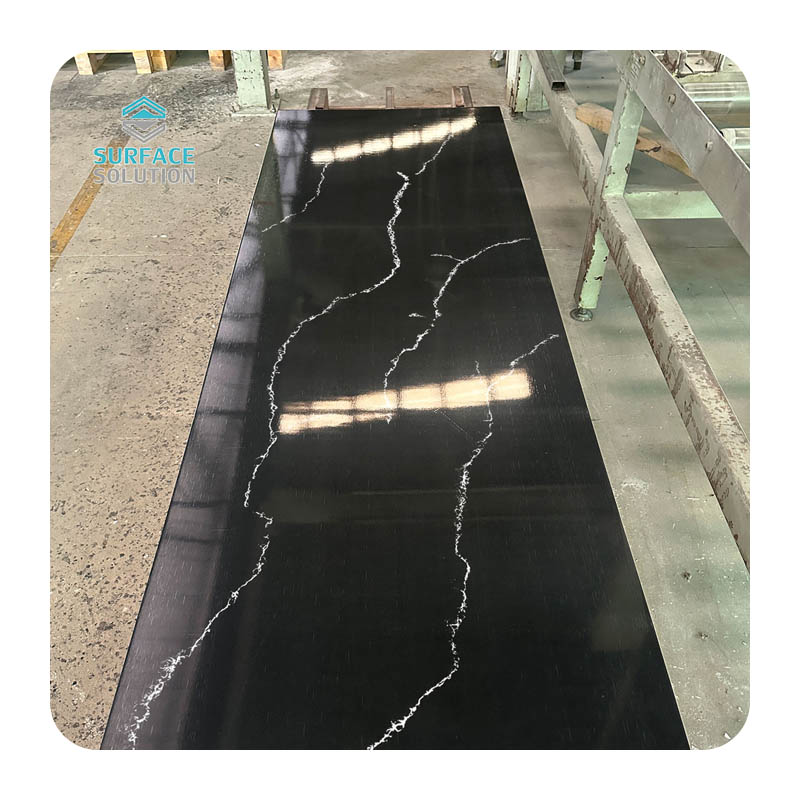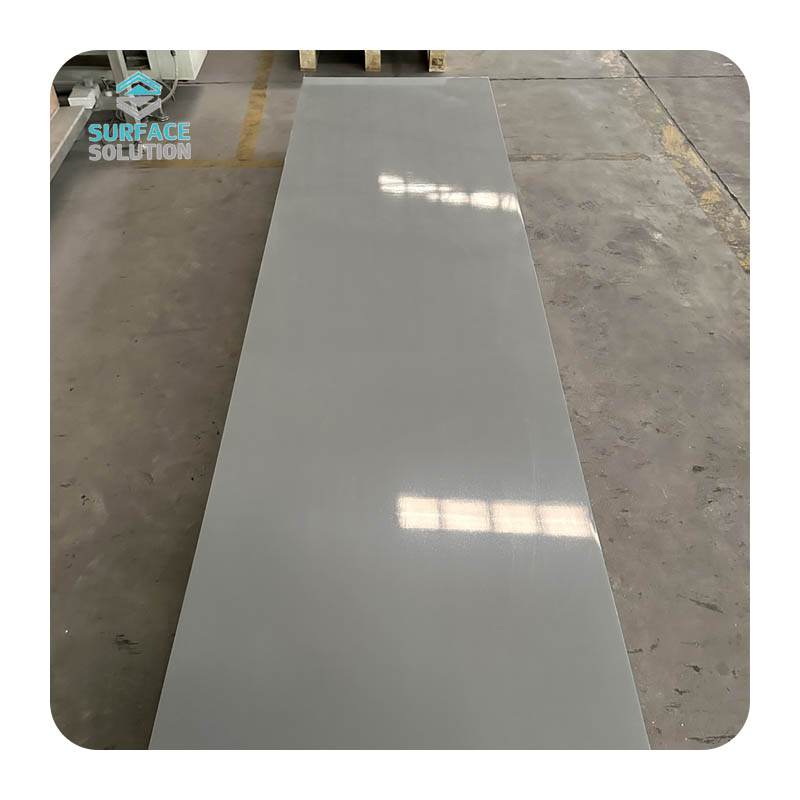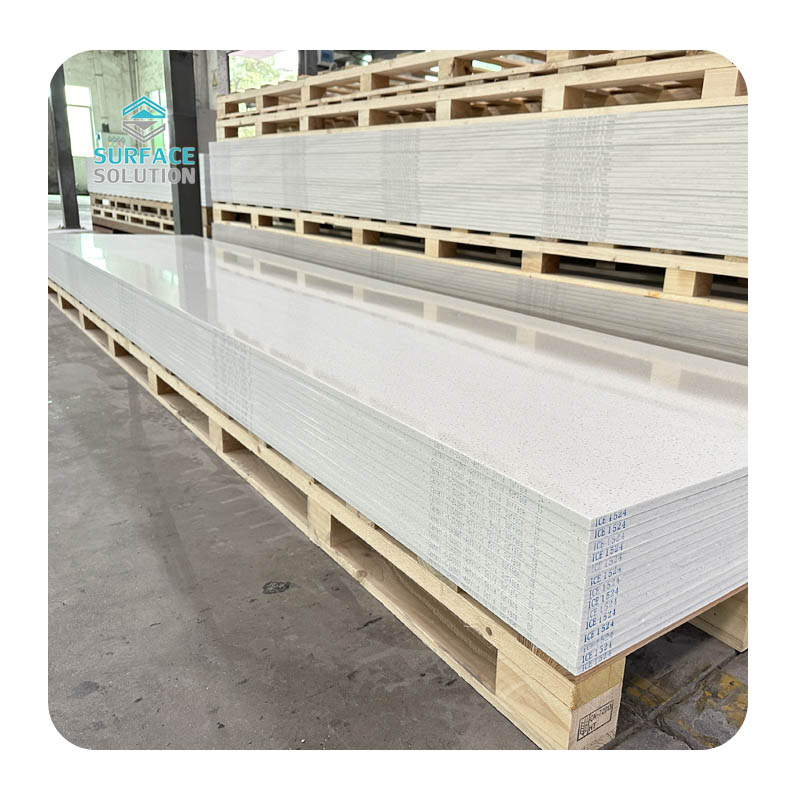

Acrylic Resins: The most prevalent choice, typically made from methyl methacrylate (MMA) or a blend of MMA and acrylic polymers. Acrylic-based solid surfaces are prized for their non-porous nature, resistance to stains and mild chemicals, and ease of repair—scratchers or small cracks can often be sanded and polished back to their original finish. They also offer excellent color consistency and can be seamlessly joined, eliminating visible seams between countertop sections.
Polyester Resins: Less common than acrylic but still used in some budget-friendly options. Polyester resins are often mixed with styrene (a liquid monomer that helps the resin cure) and may contain more volatile organic compounds (VOCs) during manufacturing. While they are durable, they tend to be slightly more porous than acrylic, making them more susceptible to staining if not properly sealed. They also have a narrower range of color options and may fade slightly over time with prolonged sun exposure.

Reinforcement: It adds structural strength, preventing the countertop from bending or warping under weight (e.g., when holding heavy appliances like mixers or toasters).
Heat Resistance: ATH has a high melting point and acts as a flame retardant, making solid surface more resistant to heat damage than pure resin (though it still shouldn’t be exposed to extreme heat, like hot pans directly from the stove).
Pigments: These are added to create the wide range of colors and patterns available—from solid whites and neutrals to marbled or speckled designs that mimic natural stone. High-quality pigments ensure color consistency across the entire countertop and resist fading from sunlight or cleaning products.
Catalysts: These chemicals trigger the curing process, turning the liquid resin-filler mixture into a hard, solid material during manufacturing. The type and amount of catalyst determine how quickly the material sets, which is critical for shaping and molding.
UV Stabilizers: Especially important for acrylic-based surfaces, these additives prevent yellowing or discoloration when the countertop is exposed to sunlight (e.g., in bathrooms with large windows or kitchen islands near skylights).
Impact Modifiers: Some formulations include small amounts of rubber or plastic particles to improve impact resistance, reducing the risk of chipping or cracking if a heavy object (like a pot) is dropped on the surface.
Mixing: Resins, fillers, pigments, and additives are combined in large industrial mixers to create a homogeneous paste. The consistency of this paste is carefully controlled—too thin, and it won’t hold its shape; too thick, and it’s difficult to mold.
Molding or Extrusion: The paste is either poured into molds (to create slabs of specific sizes) or pushed through an extruder (to form long, continuous sheets). Molding allows for more customization (e.g., curved edges or integrated sinks), while extrusion is faster and more cost-effective for standard flat slabs.
Curing: The molded or extruded material is placed in a controlled environment (often a heated oven) to cure. During curing, the catalyst reacts with the resin, causing it to harden into a solid, rigid slab. This process can take several hours to a full day, depending on the thickness of the slab.
Finishing: Once cured, the slabs are cut to size, sanded to a smooth finish, and polished. Edges are shaped (e.g., rounded, beveled, or square), and seams are joined using a resin-based adhesive that matches the countertop’s color—creating the seamless look that solid surface is known for.
Non-Porosity: The resin binder creates a tight, non-porous surface that doesn’t absorb liquids. This means no staining from coffee, wine, or oil, and it resists the growth of mold and bacteria—making it a hygienic choice for kitchens and bathrooms.
Repairability: Unlike natural stone (which can’t be easily repaired if cracked), solid surface can be sanded and polished to fix scratches, chips, or even small burns (as long as the damage doesn’t go all the way through the slab).
Customization: The manufacturing process allows for endless color and pattern options, and seamless joining means countertops can be made in large, continuous pieces—ideal for long kitchen countertops or oversized bathroom vanities.
Low Maintenance: No sealing is required (unlike granite or marble), and daily cleaning only requires mild soap and water.

Heat Sensitivity: While ATH adds heat resistance, the resin can still be damaged by extreme heat. Placing a hot pan directly on the surface can cause discoloration or even melting.
Scratch Susceptibility: The surface is softer than quartz or granite, so it can scratch from sharp objects (e.g., knives) or abrasive cleaners. However, as noted, most scratches can be repaired.
Cost: Solid surface is more expensive than laminate or tile but more affordable than natural stone or quartz.
Related Blogs
-
 What Are Solid Surface Countertops? A Complete OverviewIn kitchen and bathroom design, solid surface countertops stand out as a versatile choice, balancing functionality, aesthetics, and durability. Unlike natural stone (granite, marble) or synthetic quartz, they offer unique benefits—but what exact
What Are Solid Surface Countertops? A Complete OverviewIn kitchen and bathroom design, solid surface countertops stand out as a versatile choice, balancing functionality, aesthetics, and durability. Unlike natural stone (granite, marble) or synthetic quartz, they offer unique benefits—but what exact -
 A Comprehensive Guide to Cleaning Solid Surface CountertopsSolid surface countertops, such as surface solution, Staron, or Swanstone, have become a popular choice for modern kitchens and bathrooms due to their durability, seamless design, and resistance to stains. Unlike natural stone like granite or marble,
A Comprehensive Guide to Cleaning Solid Surface CountertopsSolid surface countertops, such as surface solution, Staron, or Swanstone, have become a popular choice for modern kitchens and bathrooms due to their durability, seamless design, and resistance to stains. Unlike natural stone like granite or marble, -
 What Is Solid Surface Material? A Complete GuideIn the world of interior design and home renovation, "solid surface material" is a term frequently heard—but what exactly is it? Unlike natural materials mined from the earth or rigid synthetic alternatives, solid surface is a engineered man-made mater
What Is Solid Surface Material? A Complete GuideIn the world of interior design and home renovation, "solid surface material" is a term frequently heard—but what exactly is it? Unlike natural materials mined from the earth or rigid synthetic alternatives, solid surface is a engineered man-made mater -
 What Are Solid Surface Countertops Made Of? A Comprehensive BreakdownSolid surface countertops have become a popular choice in modern kitchens and bathrooms, celebrated for their seamless appearance, durability, and versatility. Unlike natural stone (such as granite or marble) or ceramic tiles, soli
What Are Solid Surface Countertops Made Of? A Comprehensive BreakdownSolid surface countertops have become a popular choice in modern kitchens and bathrooms, celebrated for their seamless appearance, durability, and versatility. Unlike natural stone (such as granite or marble) or ceramic tiles, soli

















